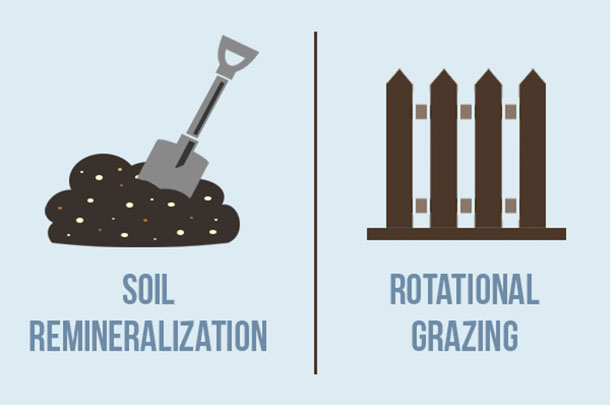If livestock are eating higher quality forage, they are more likely to grow better and have an overall healthier lifestyle,” says Cameron Flowers, Correspondent Lender for AgAmerica Lending covering the Carolinas and Virginia. “If the animal is healthier and happier, its meat is of better quality when it reaches the consumer.”

Soil Remineralization
In a lot of ways, soil is like a crops’ immune system; it helps determine a plant’s health and the nutrient density of its crop. If the soil is deficient in a certain element, the plants produced in it will be, too, as will the cattle grazing the land. Ensuring your soil has the optimal balance of macronutrients and organic matter through remineralization can help increase yields and forages.
Dr. Maria Lucia Silveira, associate professor at the University of Florida’s Range Cattle Research and Education Center, recommends farmers test their soil by collecting a representative sample and having the sample analyzed by a reputable laboratory to determine the soil’s chemical and physical properties.
If your soil is determined to be lacking a certain macronutrient like nitrogen, phosphorus, or potassium, or a trace mineral or nutrient such as chlorine, iron, or zinc, the next step would be to restore balance by carefully adding the missing elements back in. Based on your soil’s test results, cost-effective fertilization and remineralization programs can be developed to help bring your soil back to life and optimize forage production.
Rotational Grazing
Rotational grazing is a sustainable agriculture practice that can have a significant overall impact on soil health by improving soil fertility. Many pastures are continuously grazed, meaning the cattle graze one pasture throughout the season, resulting in lower yields as the forages are not allowed time to recuperate. Hunter Helms, Correspondent Lender for AgAmerica Lending in Texas, notes “overgrazed grasses and plants are less healthy than those that have had time to develop a good root system. Well-developed roots will lead to more organic matter and ultimately, healthier soil conditions.”
Managing pastures through the implementation of a rotational grazing program, where you move your cattle to different sections of pastureland on a set schedule, allows your soil and forage plants the opportunity to recover during the resting periods.
“Rotational grazing is a huge component in helping keep your soil and pastures in top condition,” Flowers adds. “Rotating cattle consistently throughout different pastures or paddocks benefits the forage and soil in several ways. The forage is only eaten to a pre-determined, uniform length, and isn’t scalped to the ground in spots. There isn’t as much wear and damage to the grass because the cattle are not continuously walking over the pasture: they get in, eat the grass to the desired length, and are then moved to the next pasture. This allows the grass to recover and rejuvenate its growth. Also, the fertilizer from manure is spread more consistently when rotating, which further benefits the soil.”
At AgAmerica Lending, we’re committed to finding unique solutions for our clients. As the nation’s premier agricultural land and rural infrastructure lender, we help agribusinesses large and small grow and prosper with our low interest rates, long amortizations, and an outstanding 10-year line of credit.
Find out more about AgAmerica’s custom loan products by contacting us today. ![]()







